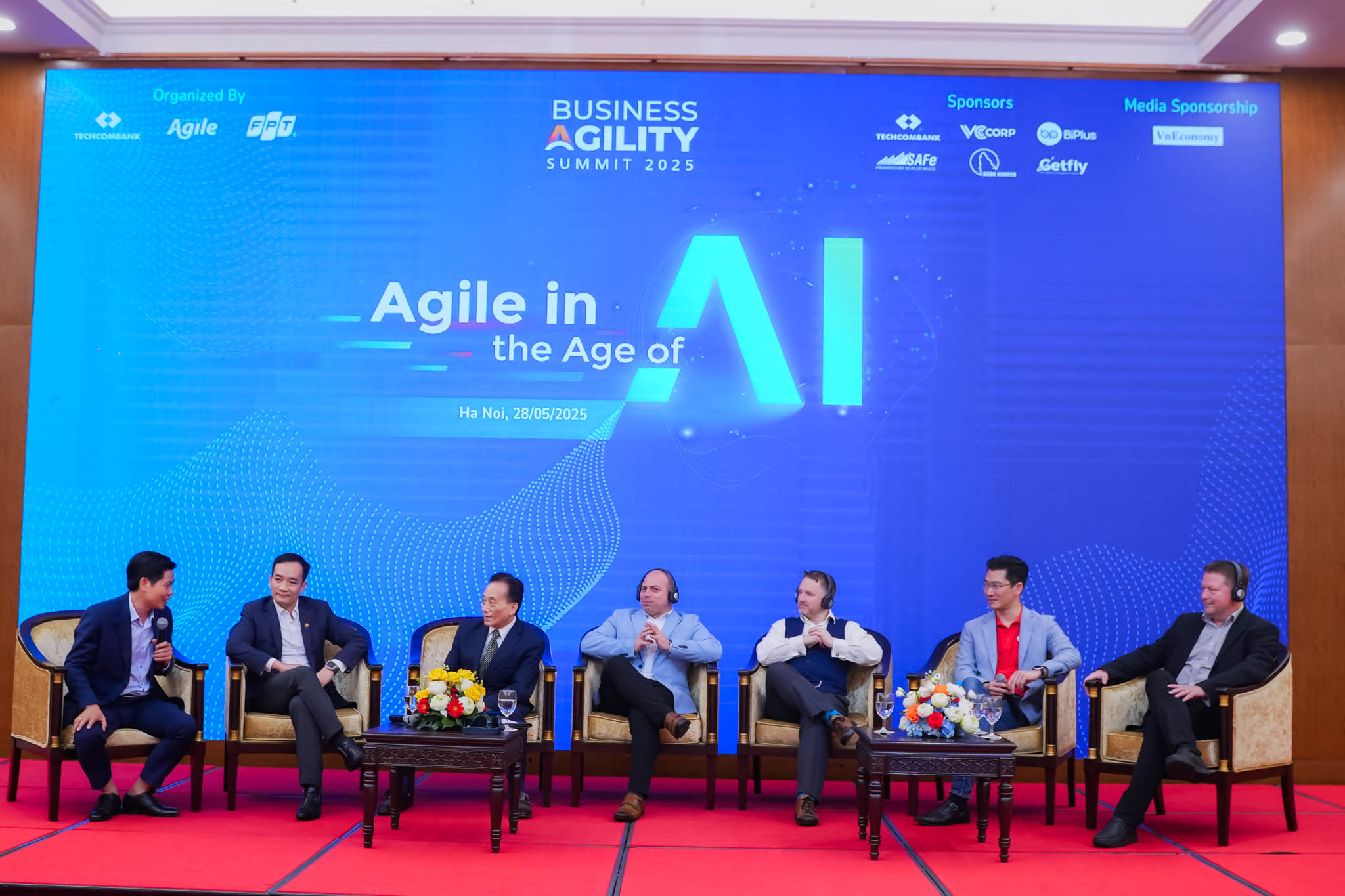The first and largest international Agile conference dedicated to Agile organizations in Vietnam, with the theme “Agile in the Age of AI”, was held recently. It focused on discussing Agile and digital transformation stories within Vietnamese enterprises, offering diverse perspectives from consulting experts and leaders of banks and multi-industry corporations.
On the sidelines of the conference, Mr. Vu Tung Lam, Head of Agile, Corporate Strategy & Transformation, at Techcombank, held an exclusive interview with Vietnam Economic Times / VnEconomy.

Digital transformation is no longer an option but a necessity for organizations and businesses. As a major bank in Vietnam, what solutions is Techcombank implementing to accelerate digital transformation?
Thank you for the questions. Techcombank has been utilizing many different platforms and centralized data and investing heavily in talent. These are the three pillars of the bank’s transformation, with the customer at the center. In the spirit of today’s conference, where we’re discussing Agile, Techcombank sees it as the “superglue” that brings all components together: platforms, digital, data, and talent. Techcombank has its own Agile way of working, called the “Techcomway”, and we are very proud of it. We view it as a superpower - the bank’s secret superpower - to unlock the potential of all of our investments.
Could you touch on the difficulties Techcombank has encountered during the digital transformation process?
Any large organization adopting Agile at scale will likely face a few significant questions, and we are no exception. We started our journey with extensive exploration and very broad options in terms of how to bring diverse ideas from the field and different Agile practices together. I believe the first two years of our transformation were marked by a lot of exploration, bringing in various ideas that we tried out. At the end of the two years, we realized one crucial thing: to truly move fast and scale, we needed to find a way to converge all those ideas, to combine them. This gave birth to the need for our own unique way of doing things, one that is highly tailored and optimized for Techcombank’s organizational context. The “Techcomway” was born of this necessity.
I think the second challenge, among many, would be the workforce - the people doing the work. The Vietnamese market has experienced about 20 to 30 years of robust outsourcing. So, the talent we have is very proficient in certain areas. However, for digital transformations and Agile transformation, there is a gap between what the market offers and what different organizations truly need. We realized we couldn’t rely solely on local talent to meet and supply that need. So, one of the important things for Techcombank is to build our own talent around Agile. We have different programs, but one key aspect is that once we created a very specific way of working - the “Techcomway” - the next step was to educate and train a large pool of specialists and Agile professionals. These individuals would be the champions to help the organization navigate the next phases and overcome the challenges we encounter along the way.
What competitive advantages do the application of AI and Agile bring to Vietnam’s banking and finance sector?
I just had a chat with an expert about Agile and AI, and interestingly, the challenges we see in adopting Agile are very similar to the challenges we encounter in Agile and digital transformation. AI is a new technology with a lot of promise, and what truly matters in this equation is an organization’s ability to, again, understand the customer’s needs and pinpoint them. From there, we need to consider what we can offer the customer. AI is probably a game-changing tool, but the fundamental question remains the same: what does it offer the customer?
The second question is about whether we can bring together ideas for new products, new services, and new innovations that are AI-powered to better serve the customer. That fundamental question is the same. How we do it might change and be completely different with AI, but the core business question remains. And the third part is: Is this commercially viable? Can we make money from it? Can we grow a market with it?
So again, it’s not about big data or AI; it’s about empathizing with customers. From that empathy, we understand them and bring them offerings that are far more advanced than what they experience today. Then, we craft a business model around that, making it both economically viable and customer-satisfying. That’s how you get a good formula.
From your observation, how does the pace of technology adoption in Vietnam’s banking and finance sector compare to other countries worldwide?
I think Vietnam is very much on par in terms of awareness of new technologies. As a culture, I believe we are very eager to learn, especially from other people, other countries, and other organizations. So that’s positive. The topics we discuss in Vietnam are probably the same as those discussed elsewhere. However, in terms of readiness, infrastructure, and capability, we are probably not yet fully prepared; there’s likely a gap. That is a very difficult gap to overcome, but I believe that once we focus on it, we can overcome these challenges.
Another point is that, given all these challenges, Vietnam probably has an advantage because most organizations here face the skill problem. Usually, for example, banks typically operate within Vietnam and not in multiple markets. Therefore, the problem we need to solve is simplified, it’s a lot simpler. We also need a robust legal corridor. So, the government plays a strong role in paving the way, informing different organizations and enterprises what they can and cannot do, drawing clear lines, and avoiding too many grey areas. I believe that by combining all of this with good collaboration between the government and the private sector, along with some large enterprises leading the way, we can tackle these challenges. These challenges aren’t entirely new; every country faces them. And we have proven in our history that we can overcome any challenges.
If you were to “score” the level of AI application and agility in the Vietnam’s banking and finance sector on a scale of 1 to 10, what score would you give it?
I don’t know for sure, but I think it’s somewhere in the middle. If you consider advanced economies to be around 9 or 10, and more developed countries around 7 to 8, my personal opinion is that we are in the learning phase. Some organizations are taking steps to prepare and strategize, but we’re not too far behind the latest trends, perhaps six months to a year.
With Vietnam not yet leading but making rapid progress, and considering its current “score”, how do you envision the future of technology application, especially AI, in its banking and finance sector over the next 2-3 years?
I speak from my own experience and will not claim to be an expert on the entire industry. However, from Techcombank’s perspective, we have always been preparing ourselves for disruptive technologies. I mentioned the bank’s three pillars: digital platforms, data, and talent. If you think about AI, it requires very organized, centralized data from which you can draw insights about business operations, customer behavior, and so on. AI will thrive when there’s a ready-to-go digital platform and people who know how to use it. Techcombank has spent many years, especially the last five, investing in these three pillars. I believe we are ready, and we have strategies in place to explore and integrate what AI can unlock into the bank’s operations. So, I am very excited to see what will unfold.









 Google translate
Google translate